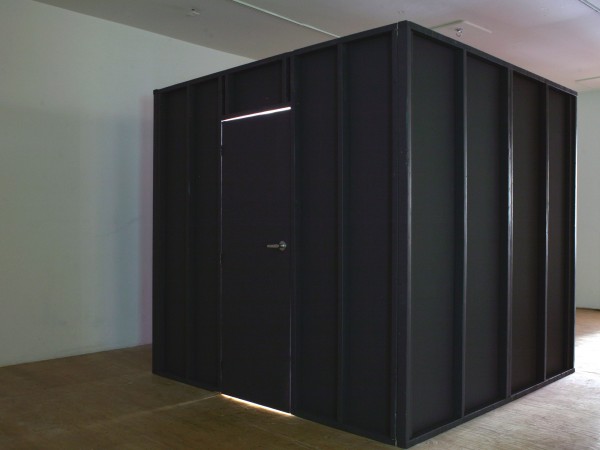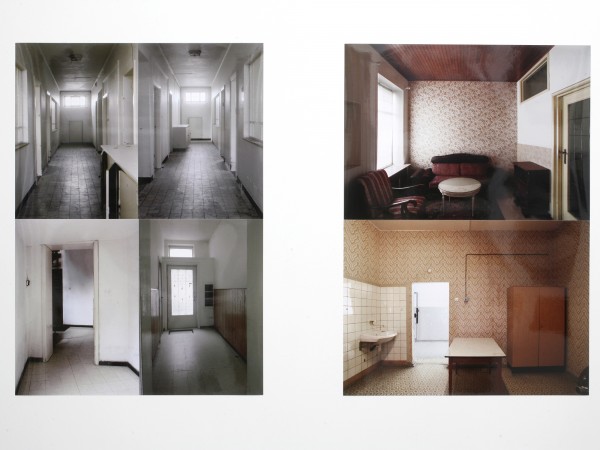The fourth edition of the Manif d’art TOI/YOU: La Rencontre was held in the capital in May and June of 2008, offering an opportunity to immerse ourselves in the work of a number of renowned contemporary artists. Amongst them, was the work of Els Vanden Meersch, who had travelled from Belgium to undertake a residency at LA CHAMBRE BLANCHE. The installation that Vanden Meersch presented, entitled Intérieurs exclus, left no one indifferent.
A retrospective tour
In the high-ceiling gallery space, a glow is reflected on the wall facing us as we enter. To this presence is added the echo of our footsteps. To the right, a black structure evokes the form of containers that are used in maritime transport. Our attention is first drawn towards this form, this abyss-like block, resembling an improvised anti-nuclear bunker. A narrow doorway gives us access to the form: the most daring enter closing the door behind them.
Inside, a number of fluorescent tubes assault our eyes, forcing us to readjust our vision from the dimly-lit space that went before. A cold and raw light is reflected within the white walls of the space, which are covered with gloss-finish photographic prints. The bright colors in the photographs draw us to them, eager to discover the subject matter that is depicted within: places and rooms denuded of all human presence, creating a mise en abîme of the senses and the situation in which we find ourselves.
On first glance, the criteria governing the arrangement of images – in groups of three and four, attached directly to the wall – is not clear to us. These ephemeral compositions1 are arranged according to strict geometric patterns. The colours, spaces and points of view depicted (with their subjective framing at eye level) seem to echo one another, as the architecture that they portray all seems to be have been created by the same hand. The atmosphere is heavy, stifling our breathing. Where are we ? It is impossible to know; no indications are given as to the whereabouts of these places. As one image follows another, the sense of claustrophobia becomes overwhelming. These seem to be warehouses, decontamination rooms. Then, an image of an image of the tracks leading to the Auschwitz concentration camp gives us a clue as to the symbolic significance of the spaces that we have witnessed.
In our minds, all of the unknown places on view take on an uncertain presence. They are, in fact, abandoned bunkers, gas chambers and the cramped apartments constructed by totalitarian regimes in the course of the last century. There is a sad awakening: our faulty memory is not able to discern the specific whereabouts of any of the scenes portrayed. They all look the same; a similar atmosphere reigns. Even though we are seeing them for the first time, they seem familiar, as though the horror and uncomfortableness of those who have passed through the space before us is imbibed in the walls. The grease and soot marks of the many histories to which we no longer have access seem to linger in the space; a form of suffocating poetry emerges. No longer able to endure it, we leave.
Elsewhere, in the main space, a series of images is projected, following a steady rhythm. The images dissolve, one by one. The tightly and identically framed photographs display a series of brightly-colored, deserted rooms. A window – always the same window – opens out onto a landscape that reoccurs as far as the eye can see. Once again, we have no way of knowing where we are.
After a few minutes, doubt takes hold: what we see before us is not a hospital, not a hotel. Its sense escapes us, yet its sense is everywhere in the succession of images. Each room has the same silence, or almost, save for the effect of time on the blistering of the paint on the walls, the crumbling their surfaces, and the rusting of radiators. Today, these once-identical interiors have taken on the patina that only time and nature know how to inflict on man’s pride and his possessions. The lesson is an eloquent one and an ironic one: each room has become unique. Life has taken hold once more. However quiet and perfectly white the surfaces before us once were (walls, floors and ceilings) they have all become textured and, to the contemporary eye, beautiful. However unclear we are about what this succession of images depicts, it would never have crossed our minds that what we are witnessing is a site that is highly-charged with significance: a seaside resort designed according to modernist and functionalist principles under Nazi Germany. Built to be indestructible, the three-kilometer length of the Prora complex on Rügen island has resisted all attempts to demolish it.
As these links reveal, the places presented by Els Vanden Meersch in the exhibition are the vestiges of totalitarian ideologies that sought to destroy all sense of individuality. They did so by purging all decorative features in space, in favor of an implacable and moribund standardization of the spaces in which man lives and works. The coldness of the places portrayed by the artist invokes both the imperative that we remember, and constitutes a photographic document of the utopian formulas and eugenic visions of these decrepit regimes for whom instrumentalized reason took precedent over fundamental differences between human beings. Thus, a single, unique being is repeated, endlessly, in the same environment, reified by the staggering domination of the State and industry, and drawn towards the certain death of individual creativity. Here is humanity objectified, become an inert, mineral statue, difference washed away with quicklime, difference betrayed by a fascinating machine that seems to have penetrated all spheres of life, and the very habitat of life itself. And yet, time does its work… Man has naturally and completed deserted this concrete microcosm to find a place to live freely, in the suburbs.
- Throughout her residency, Els Vanden Meersch adjusted the content and the arrangement of the imagery on display.


